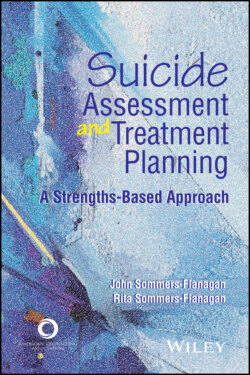Читать книгу Suicide Assessment and Treatment Planning - John Sommers-Flanagan - Страница 28
The Seven Dimensions
ОглавлениеCounseling and psychotherapy theorists and practitioners have a long history of using dimensional models to formulate client problems and develop treatment plans (Ellis, 1962; Lazarus, 2006; Myers, 1991; Witmer & Sweeney, 1992). Many authorities in many disciplines have articulated life dimensions. Some argue for three, others for five, seven, or nine dimensions. We settled on seven that we believe reflect common sense, science, philosophy, and convenience. Each dimension is multifaceted, overlapping, dynamic, and interactive. Each dimension includes at least three underlying factors that have theoretical and empirical support as drivers of suicidal ideation or behavior (J. Sommers-Flanagan, 2018a). The dimensions and their underlying factors are shown in Table 1.1.
In her memoir, Judy Collins (2003) wrote, “Two questions that are at the heart of treating someone who wishes to end their life are: ‘Where does it hurt?’ and ‘How can I help you?’” (p. 117). The “hurt” Collins refers to is not always located in a single place. Chronic pain, social isolation, lack of employment or shelter, emotional turmoil, constricted thinking, destructive habits, addictions, existential nihilism, and many more factors can trigger suicidality.
Given the immense range and complexity of human suffering and helping options, we believe that organizing our search for “where it hurts” and “how we can help” is essential. Using the seven-dimension model for case formulation will make it easier to notice and nurture client strengths. In addition to Collins’s questions of “Where does it hurt?” and “How can I help you?” we add “Where are you strong?”
TABLE 1.1 Brief Descriptions of the Seven Dimensions
| Dimension | Evidence-Based Suicide Driver | Wellness Goal |
| Emotional | ||
| All human emotions Cognitive | 1. Excruciating emotional distress | 1. Emotional peace and calm |
| 2. Specific disturbing emotions (guilt, shame, anger, or sadness) | 2. Specific positive emotions (happiness, joy, etc.) | |
| 3. Emotional dysregulation | 3. Emotional regulation | |
| All forms of human thought, including imagery Interpersonal | 1. Hopelessness | 1. Hope |
| 2. Problem-solving impairments | 2. Problem-solving skills | |
| 3. Maladaptive thoughts | 3. Adaptive thoughts and beliefs | |
| 4. Negative core beliefs | 4. Positive core beliefs | |
| All human relationships | 1. Social disconnection and perceived burdensomeness | 1. Social connection and perceived usefulness |
| 2. Interpersonal loss and grief | 2. Skills for coping with loss | |
| 3. Social skill deficits | 3. Positive social skills | |
| 4. Repeating dysfunctional relationship patterns | 4. Repeating functional relationship patterns | |
| Physical | ||
| All human biogenetics and physiology | 1. Biogenetic predispositions and physical illness | 1. Healthy biogenetics and wellness |
| 2. Sedentary lifestyle, poor nutrition | 2. Active lifestyle, positive nutrition | |
| 3. Agitation, arousal, anxiety | 3. Physical calmness | |
| 4. Trauma, nightmares, insomnia | 4. Skills for coping with trauma | |
| Cultural-spiritual | ||
| All religious, spiritual, or cultural values that provide meaning and purpose | 1. Religious or spiritual disconnection | 1. Religious or spiritual connection |
| 2. Cultural disconnection or dislocation | 2. Cultural connection | |
| 3. Meaninglessness | 3. Meaningfulness | |
| Behavioral | ||
| All human action and activity Contextual | 1. Using substances or cutting for desensitization | 1. Openness to experience |
| 2. Suicide planning, intent, and preparation | 2. Life planning and preparation | |
| 3. Impulsivity | 3. Self-control | |
| All factors outside of the individual that influence human behavior | 1. No connection to place or nature | 1. Connection to place or nature |
| 2. Chronic exposure to unhealthy environmental conditions | 2. Healthy environmental conditions | |
| 3. Socioeconomic oppression or resource scarcity (e.g., poverty) | 3. Socioeconomic support, resources, and social justice |
